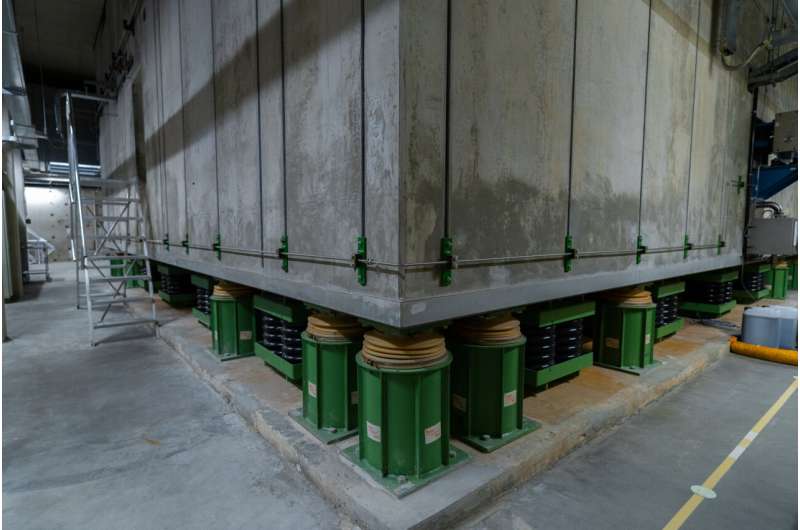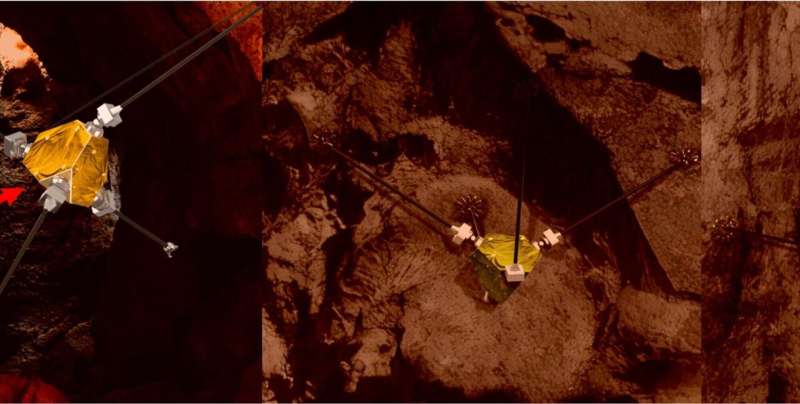NASA's Lunar Trailblazer gets final payload water hunt
Thursday, 17 August 2023 09:26 The spacecraft's Lunar Thermal Mapper science instrument will work with an imaging spectrometer to help researchers understand the nature of water on the Moon's surface. NASA's Lunar Trailblazer is nearing completion now that its second and final cutting-edge science instrument has been added to the small spacecraft.
Built by the University of Oxford in England and contributed by the UK
The spacecraft's Lunar Thermal Mapper science instrument will work with an imaging spectrometer to help researchers understand the nature of water on the Moon's surface. NASA's Lunar Trailblazer is nearing completion now that its second and final cutting-edge science instrument has been added to the small spacecraft.
Built by the University of Oxford in England and contributed by the UK Air Force selects Wallaroo.AI for On-Orbit AI advancements
Thursday, 17 August 2023 09:26 Wallaroo.AI, known for their expertise in scaling production machine learning (ML) from the cloud to the edge, has been chosen by AFWERX, the innovation branch of the Department of the Air Force, for an STTR Phase II contract. This collaborative endeavor will address significant challenges within the Department of the Air Force.
The initiative has seen support and collaboration between the
Wallaroo.AI, known for their expertise in scaling production machine learning (ML) from the cloud to the edge, has been chosen by AFWERX, the innovation branch of the Department of the Air Force, for an STTR Phase II contract. This collaborative endeavor will address significant challenges within the Department of the Air Force.
The initiative has seen support and collaboration between the A 'Blissful' Martian Rock Paradise, Straight Ahead: Sols 3919-3920
Thursday, 17 August 2023 09:26 Earth planning day: Monday, August 14, 2023: The Gediz Vallis Ridge represents a hugely interesting and enigmatic feature, one that we have been talking about since landing (and probably well before that), but one that seemed so very very far away. We have been discussing science goals and campaigns for when we reach it at our bi-annual long term planning meetings .... and every chance in betwee
Earth planning day: Monday, August 14, 2023: The Gediz Vallis Ridge represents a hugely interesting and enigmatic feature, one that we have been talking about since landing (and probably well before that), but one that seemed so very very far away. We have been discussing science goals and campaigns for when we reach it at our bi-annual long term planning meetings .... and every chance in betwee Atlas Credit Partners provides $100M strategic financing to AST SpaceMobile
Thursday, 17 August 2023 09:26 Atlas Credit Partners ("ACP"), an asset management firm specializing in investing and partnering with businesses on a direct basis, has announced a $100 million strategic financing to AST SpaceMobile, Inc. ("AST") (NASDAQ: ASTS), with approximately $50 million funded at closing.
The ACP credit facility will provide AST with additional resources to continue building a globally connected sat
Atlas Credit Partners ("ACP"), an asset management firm specializing in investing and partnering with businesses on a direct basis, has announced a $100 million strategic financing to AST SpaceMobile, Inc. ("AST") (NASDAQ: ASTS), with approximately $50 million funded at closing.
The ACP credit facility will provide AST with additional resources to continue building a globally connected sat Mil-Aero 6 GHz Link: ViaLite's answer to Japan's demanding satcom needs
Thursday, 17 August 2023 09:26 Tokyo's satellite communication industry has seen the recent introduction of ViaLite's Mil-Aero 6 GHz Link Pair, an advanced piece of technology designed to meet high-grade requirements for C-band RF over fiber operation. This innovative solution not only achieves market-leading operations within this range but also extends its capabilities to cover other well-known Satcom bands ranging from 10
Tokyo's satellite communication industry has seen the recent introduction of ViaLite's Mil-Aero 6 GHz Link Pair, an advanced piece of technology designed to meet high-grade requirements for C-band RF over fiber operation. This innovative solution not only achieves market-leading operations within this range but also extends its capabilities to cover other well-known Satcom bands ranging from 10 Japan's space system utilizes AWS Snowcone for space-to-Earth data delivery
Thursday, 17 August 2023 09:26 Approximately 400 kilometers above the Earth's surface, Japan Manned Space Systems Corporation (JAMSS) used an AWS Snowcone SSD onboard the International Space Station (ISS) to quickly and autonomously transmit large volumes of data from space back on the ground into Amazon Web Services (AWS). The AWS Snowcone, which arrived on the ISS in July 2022 as part of the first Axiom Space Mission (Ax-1)
Approximately 400 kilometers above the Earth's surface, Japan Manned Space Systems Corporation (JAMSS) used an AWS Snowcone SSD onboard the International Space Station (ISS) to quickly and autonomously transmit large volumes of data from space back on the ground into Amazon Web Services (AWS). The AWS Snowcone, which arrived on the ISS in July 2022 as part of the first Axiom Space Mission (Ax-1) Delight at Dream Lake
Thursday, 17 August 2023 09:26 The rover has left behind the boulder field at "Fall River Pass" for now, and we're currently investigating an enigmatic sedimentary rock unit that was first spotted by Ingenuity during its 52nd flight several weeks ago. This is a great example of how Ingenuity's unique aerial perspective can help us scout out areas of interest ahead of the rover.
This rock is located within a linear troug
The rover has left behind the boulder field at "Fall River Pass" for now, and we're currently investigating an enigmatic sedimentary rock unit that was first spotted by Ingenuity during its 52nd flight several weeks ago. This is a great example of how Ingenuity's unique aerial perspective can help us scout out areas of interest ahead of the rover.
This rock is located within a linear troug NASA challenges students to fly Earth and Space experiments
Thursday, 17 August 2023 09:26 NASA is calling on middle and high school students across the country to submit experiment ideas for a high-altitude balloon or rocket-powered lander test flight in the third TechRise Student Challenge.
TechRise is open to students in grades six to 12 attending U.S. public, private, or charter schools - including those in U.S. territories. It offers participants hands-on insight into the p
NASA is calling on middle and high school students across the country to submit experiment ideas for a high-altitude balloon or rocket-powered lander test flight in the third TechRise Student Challenge.
TechRise is open to students in grades six to 12 attending U.S. public, private, or charter schools - including those in U.S. territories. It offers participants hands-on insight into the p Terran Orbital expects $180 million payment from Rivada Space this year
Wednesday, 16 August 2023 22:08

Chandrayaan-3 nears landing with successful orbital adjustments
Wednesday, 16 August 2023 20:10 The Chandrayaan-3 spacecraft has successfully adjusted its orbit to 153 km x 163 km, as reported by the Indian Space Research Organisation (ISRO) today. This precise maneuvering is a pivotal step as the mission gears up for its anticipated soft landing on the Moon's South Polar region on August 23.
In the days leading up to this current status, the spacecraft had undergone significant orbi
The Chandrayaan-3 spacecraft has successfully adjusted its orbit to 153 km x 163 km, as reported by the Indian Space Research Organisation (ISRO) today. This precise maneuvering is a pivotal step as the mission gears up for its anticipated soft landing on the Moon's South Polar region on August 23.
In the days leading up to this current status, the spacecraft had undergone significant orbi NASA adds water detection instrument to Lunar Trailblazer spacecraft
Wednesday, 16 August 2023 20:10 As NASA's Lunar Trailblazer spacecraft nears completion, scientists have added a piece of equipment designed to detect water.
"Built by the University of Oxford in England and contributed by the UK Space Agency, the Lunar Thermal Mapper (LTM) joins the High-resolution Volatiles and Minerals Moon Mapper (HVM3), which was integrated with the spacecraft late last year," NASA said in a pres
As NASA's Lunar Trailblazer spacecraft nears completion, scientists have added a piece of equipment designed to detect water.
"Built by the University of Oxford in England and contributed by the UK Space Agency, the Lunar Thermal Mapper (LTM) joins the High-resolution Volatiles and Minerals Moon Mapper (HVM3), which was integrated with the spacecraft late last year," NASA said in a pres Q&A: Sustainability in space travel can aid efforts here on Earth
Wednesday, 16 August 2023 19:57
Dr. Angelo Vermeulen is a space systems researcher at Delft University of Technology in the Netherlands, where he explores advanced concepts for interstellar exploration. Over the past decade, he has collaborated closely with the European Space Agency's (ESA) MELiSSA program, developing concepts for bioregenerative life support systems for space. In such systems, a variety of microorganisms progressively break down human waste and the resulting compounds are harnessed by plants to produce oxygen and food for the crew.
Beyond his scientific pursuits, Dr Vermeulen is also an accomplished artist and a co-founder of the SEADS (Space Ecologies Art and Design) collective. SEADS creates artworks that seamlessly integrate concepts and technologies from a diverse array of scientific disciplines, including biology, neuroscience, computer science, and astrophysics.
He is the author of a recently published Frontiers in Astronomy and Space Sciences article in which he and his co-authors describe a new model that theoretically produces all required food and oxygen during long-duration and remote space missions, removing the necessity for resupply from Earth.
Hydra shaker table simulates the vibration forces of a rocket launch for satellite testing
Wednesday, 16 August 2023 19:48
As the earthquake-strength Hydra shaker table simulates the vibration forces of a rocket launch for satellite testing, it is only this concrete block and the dampeners and springs supporting it that prevent the rest of the European Space Agency's ESTEC Test Center from also suffering the shakes.
The most powerful and precisely controllable of the shaker tables the ESA uses for satellite testing at its Test Center in Noordwijk, the Netherlands, is the multi-axis Hydra, which is capable of vibrating test items weighing many tons.
Seen from the cleanroom above, the hydraulically-powered Hydra appears to be simply a 5.5 x 5.5 m aluminum platform lying flush with the floor. But this plate is only the top of an 18 metric ton test table which is moveable using eight hydraulic actuators, in the same manner as a flight simulator machine.
This test table is enclosed within a 1,400 metric ton concrete 'seismic foundation' block. This block rests in turn on the set of springs and dampers, which isolate it, preventing potentially damaging vibrations from spreading through the rest of the building.
A robot with expandable appendages could explore Martian caves and cliffs
Wednesday, 16 August 2023 19:33
Plenty of areas in the solar system are interesting for scientific purposes but hard to access by traditional rovers. Some of the most prominent are the caves and cliffs of Mars—where exposed strata could hold clues to whether life ever existed on the Red Planet. So far, none of the missions sent there has been able to explore those difficult-to-reach places. But a mission concept from a team at Stanford hopes to change that.
The concept, known as ReachBot, is a robot that can support itself using multiple articulated appendages to navigate terrain that would be difficult to reach using other navigational techniques. In addition to being able to traverse complex ground patterns, it could also, in theory, at least scale sheer cliff faces.
It was initially pitched as a NASA Institute for Advanced Concepts project, where it was awarded a Phase I grant back in 2021. The authors describe the idea as a fusion of two separate technologies developed for different purposes: mobile manipulation robots and deployable space structures.
Mobile manipulation robots are relatively common in space exploration.
Momentus cuts workforce while evaluating strategic options
Wednesday, 16 August 2023 18:06


